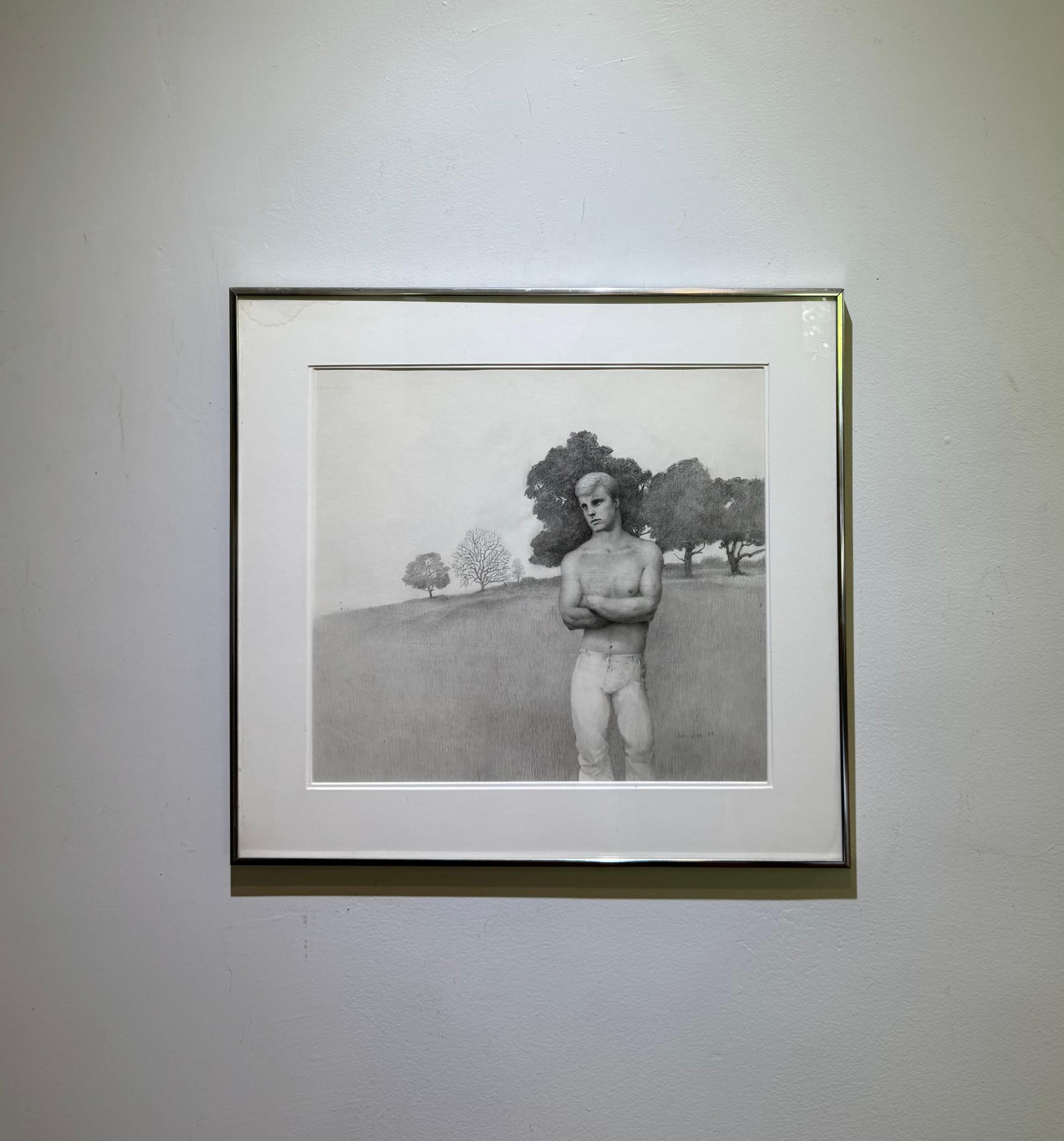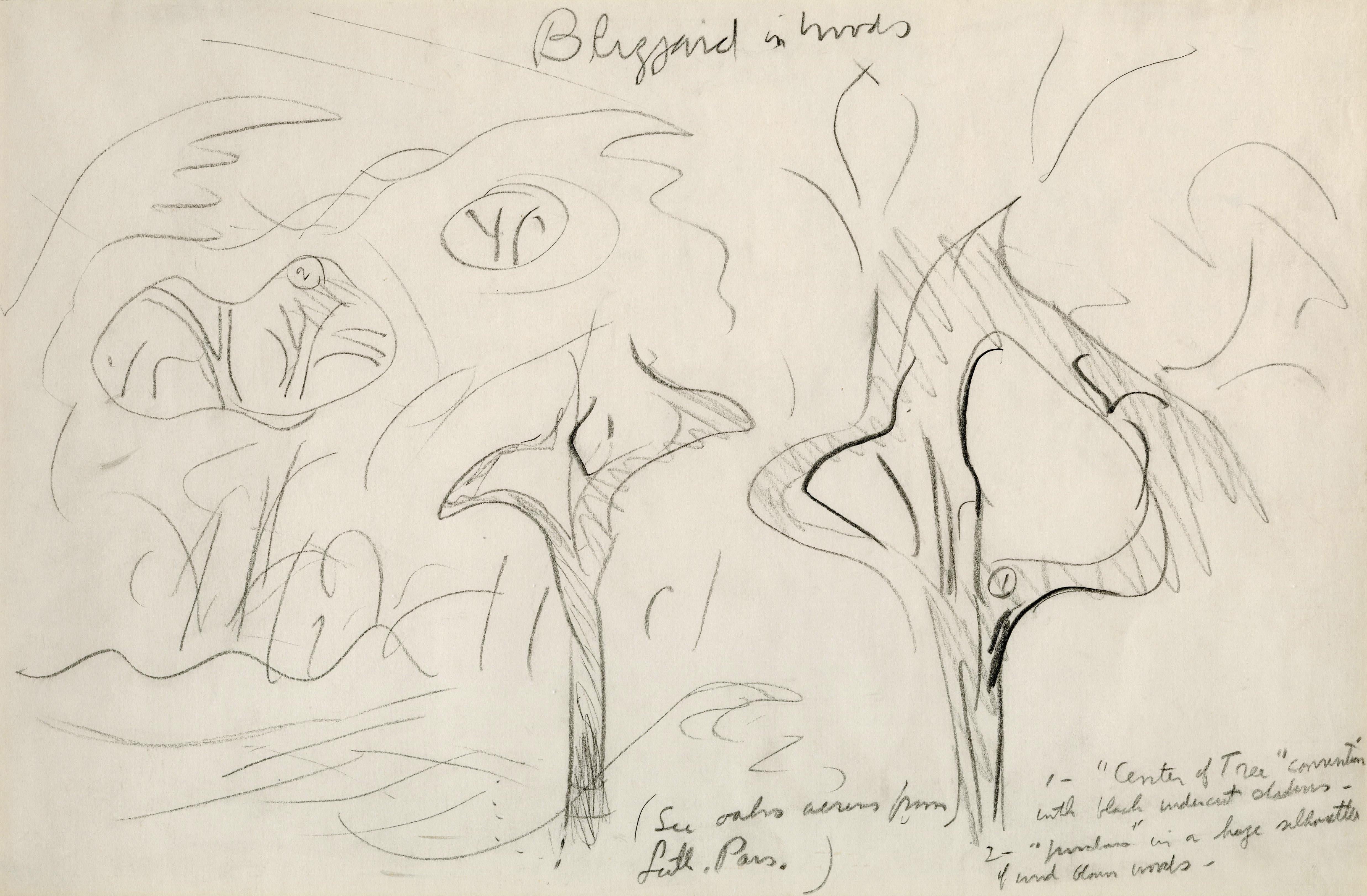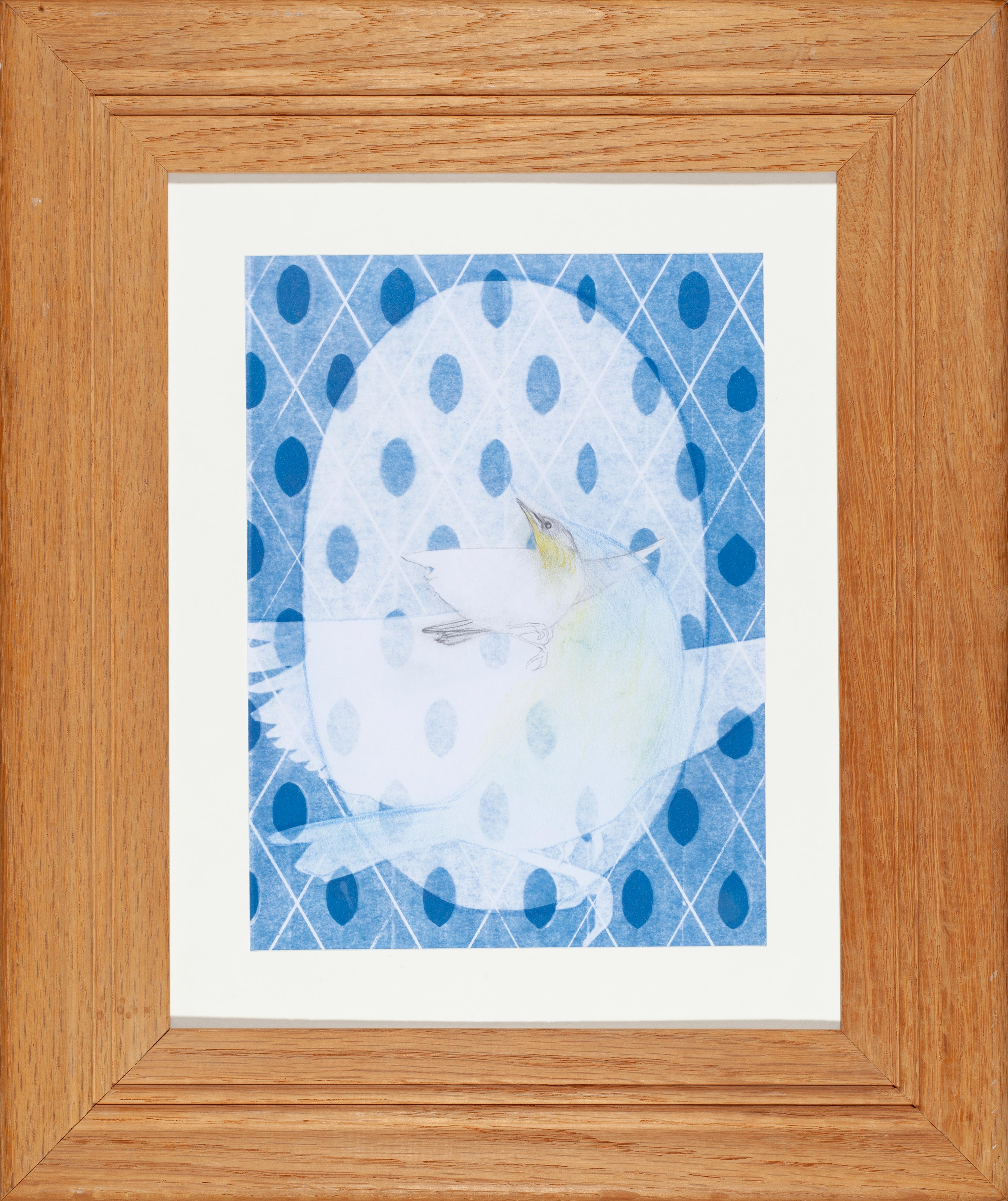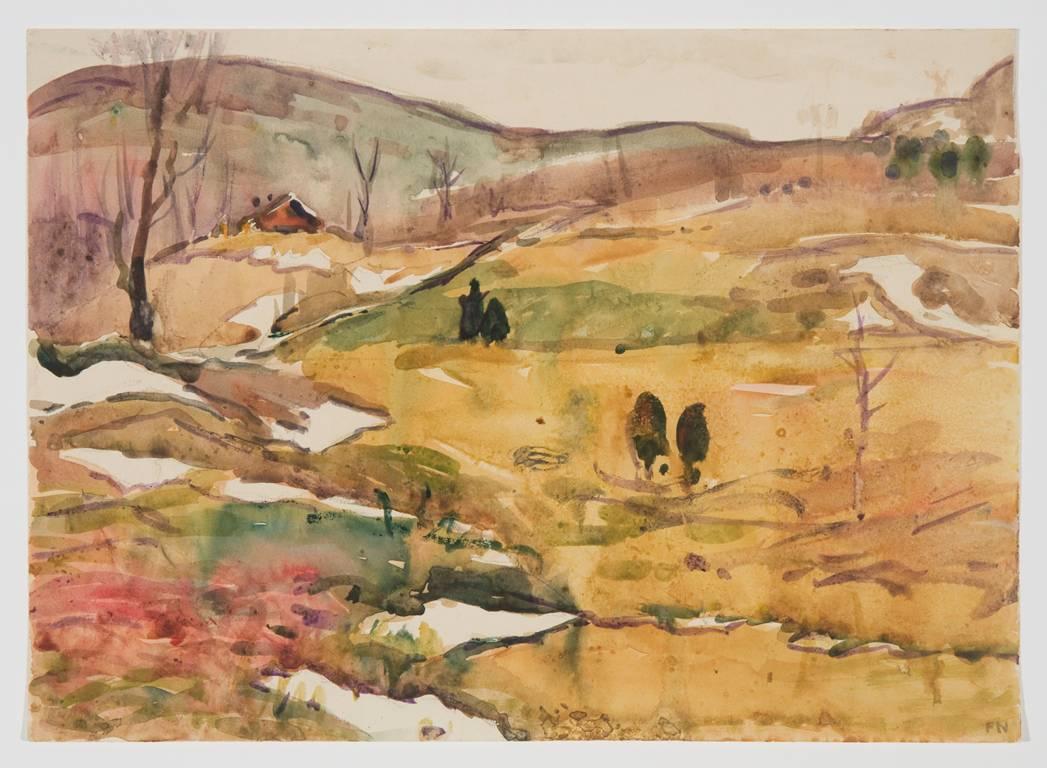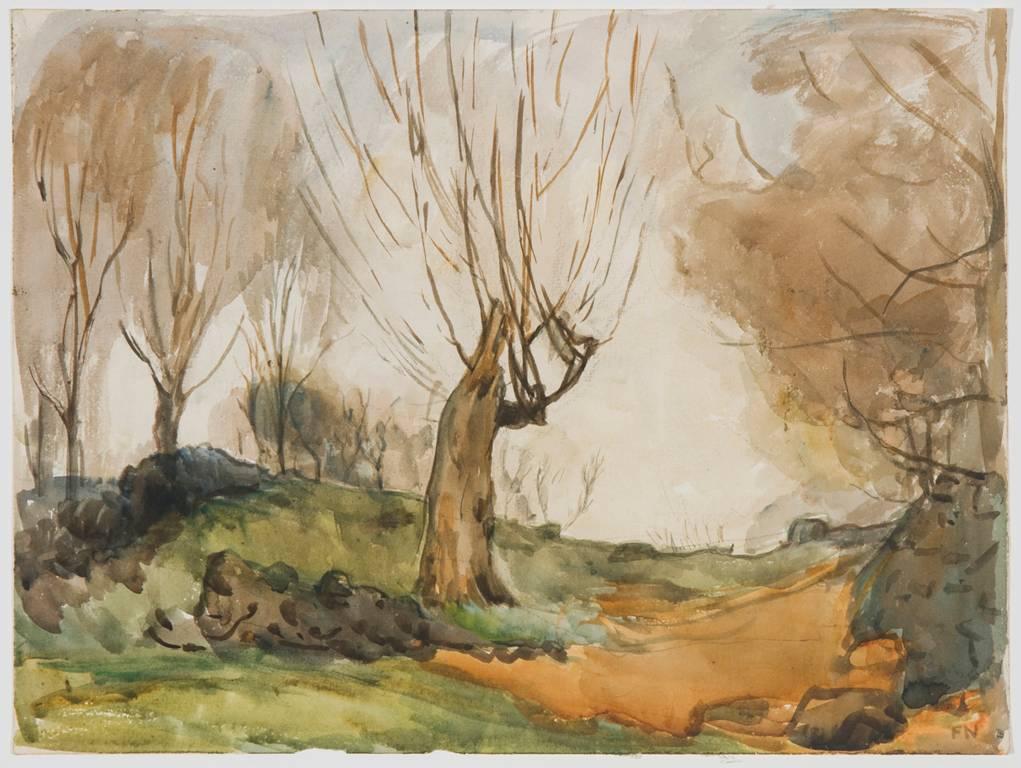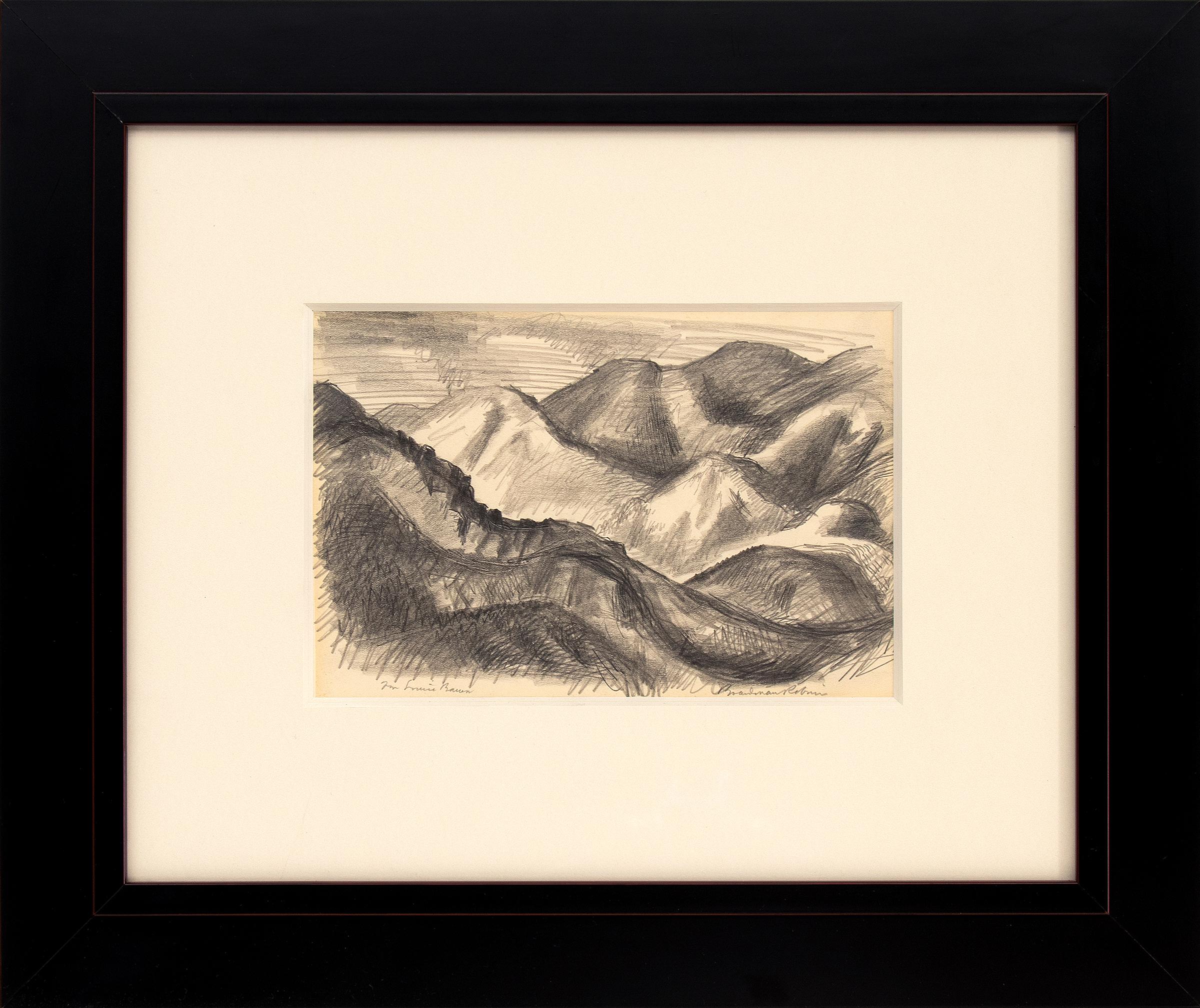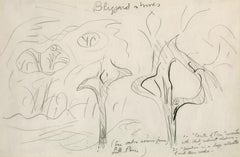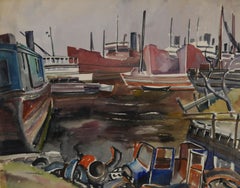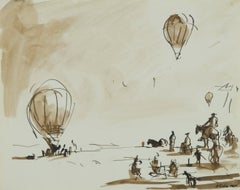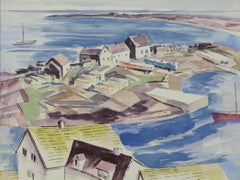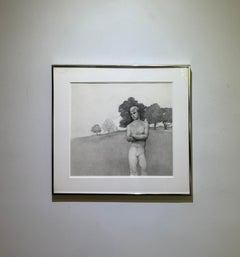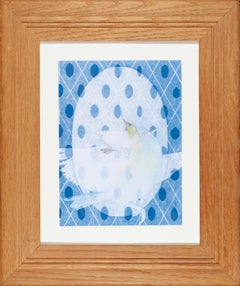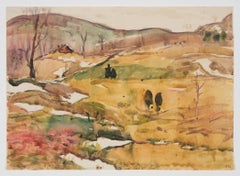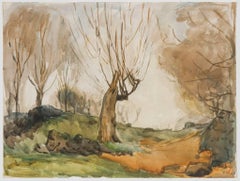Artículos similares a Brookdale, New Jersey
¿Quieres más imágenes o vídeos?
Solicita imágenes o vídeos adicionales al vendedor
1 de 7
Oscar Florianus BluemnerBrookdale, New Jersey1922
1922
Acerca del artículo
Brookdale, New Jersey
Graphite on paper, 1922
Signed with the artist's initials l.l., and dated 1922 (see photo)
Annotated "Brookdale" front and back of sheet
Condition: Excellent
Archival framing with 8 ply acid free rag matting and UV filtering glass. Housed in a Marin style metal leaf, finished corner frame
Frame size: 15 x 16-3/8 x 3/4 inches
Image size: 5 x 6 3/4 inches
Provenance: Estate of the Artist
Courtesy of Wikipedia
Oscar Bluemner (June 21, 1867 – January 12, 1938), born Friedrich Julius Oskar Blümner and after 1933 known as Oscar Florianus Bluemner, was a Prussian-born American Modernist painter.
Early life
Bluemner was born as Friedrich Julius Oskar Blümner in Prenzlau, Kingdom of Prussia (now Germany), on June 21, 1867. He studied painting and architecture at the Royal School of Art in Berlin.
Architecture
Bluemner moved to Chicago in 1893 where he freelanced as a draftsman at the World's Columbian Exposition. After the exposition, he attempted to find work in Chicago. In 1901, he relocated to New York City where he also was unable to find steady employment. In 1903, he created the winning design for the Bronx Borough Courthouse in New York, although it is credited to Michael J. Garvin. The scandal that arose around this took down borough president Louis Haffen for corruption and fraud.
In 1908 Bluemner met Alfred Stieglitz, who introduced him to the artistic innovations of the European and American avant-garde. By 1910, Bluemner had decided to pursue painting full-time rather than architecture.
He exhibited in the 1913 Armory Show. He said that the Americans' contribution failed to match that of the Europeans because the American selection process reflected rivalries and compromises rather than curatorial judgment, resulting in a "melée of antagonistic examples".Then in 1915 Stieglitz gave him a solo exhibition at his gallery, 291. Despite participating in several exhibitions, including solo shows, for the next ten years Bluemner failed to sell many paintings and lived with his family in near poverty.
He created paintings for the Federal Arts Project in the 1930s.
Later life
After his wife's death in 1926, Bluemner moved to South Braintree, Massachusetts. From there in 1932 he contributed a letter to an ongoing debate in the New York Times on the question "What is American Art?". He wrote:
“America sells its shoes, machines, canned beef and so forth in Europe and all over the world not because they have an American style or are wrapped in the American flag, but simply because they are best. Thus also, the French export their paintings and birth-control, and the Germans export sauerkraut and prima donnas, because those things, each, are best. Today, for quality, nationalism, as a race-attribute, means nothing; chemistry, astronomy, or engineering admit, nowhere, of any national flavoring, nor do higher things like religion or philosophy.
Let us, here, make progressive and best painting, each one as he is fit to do, and merely ask: What and when is painting, in a critical sense? ... How can the people agree on what is American style, if the painters themselves, and by their work, disagree profoundly as to what real painting itself is! And there is, and always was, nothing more contemptible, ridiculous and, to art, disastrous, than patrioteering, which thinly veils profiteering.
Ideally, art, pure, is of a sphere and of no country; the first real artists, always and everywhere, have either been importers or immigrants bringing the light with them. El Greco, an immigrant ... defied the Spanish professors ... ; we, now, call his work more truly Spanish than that of his local contemporaries. And in the same sense, the future will not fail to stamp that of our own work as peculiarly American in which the living painter, here, has injected no conscious thought of his hailing from Hoboken or Kankakee, and every consideration of pure and modern painting and of the supreme quality he maybe capable of.”
He had a successful one-man show in 1935 at the Marie Harriman Gallery in New York City. In the New York Times, Edward Alden Jewell called it Bluemner's "apotheosis". He wrote:
He is very much alive and has been working of late ... with robustious [sic] results. These twenty-eight canvases bear the generic title , "New Landscape Paintings." That is because Mr. Blkuemner feels that some degree of "representation" is essential if abstract ideas are to be put over with entire success. However, the artist more fully and more exactly classifies them as "compositions for color themes." He might, if he chose, even call them "color music" without risking the opprobrium that usually attends excursions into so hazardous a field. ... These startling pictures build harmonies and rhythms that depend as a rule on simple statement. Here we find none of the overtones and undertones that some other artists have employed in projecting visual music. Bluemner relies for his effect upon plain, resonant chords. Though modulations of tone occur, these seem of secondary importance in his scheme. There is decidedly something in this new, bold, exclamatory style.
Bluemner died by suicide on January 12, 1938.
Legacy
Stetson University holds more than 1,000 pieces of Oscar Bluemner's work bequeathed in 1997 by his daughter, Vera Bluemner Kouba. In 2009 the Homer and Dolly Hand Art Center at Stetson opened with a primary mission of housing a providing exhibition space for the Kouba Collection. Often overlooked in his lifetime, Bluemner now is widely acknowledged as a key player in the creation of American artistic Modernism, with better-known colleagues such as Georgia O'Keeffe and John Marin.
In 2013, the Montclair Art Museum in New Jersey presented an exhibition of Bluemner's works depicting the landscapes and industrial areas of Paterson, painted between 1910 and 1917, drawn from the Stetson holdings. It marked the centenary of the Paterson silk strike, which had inspired his politics.
An oil painting by Bluemner, Illusion of a Prairie, New Jersey (Red Farm at Pochuck) (1915) sold at Christie's, New York, for $5,346,500 on November 30, 2011.
- Creador:Oscar Florianus Bluemner (1867-1938, Americana)
- Año de creación:1922
- Dimensiones:Altura: 12,7 cm (5 in)Anchura: 17,15 cm (6,75 in)
- Medio:
- Movimiento y estilo:
- Época:
- Estado:
- Ubicación de la galería:Fairlawn, OH
- Número de referencia:Vendedor: FA37421stDibs: LU14016412952
Sobre el vendedor
5,0
Vendedor reconocido
Estos prestigiosos vendedores son líderes del sector y representan el escalón más alto en cuanto a calidad y diseño de artículos.
Vendedor Oro
Vendedores premium que mantienen una calificación de +4,3 y tiempos de respuesta de 24 horas
Establecido en 1978
Vendedor de 1stDibs desde 2013
789 ventas en 1stDibs
Tiempo de respuesta usual: <1 hora
Asociaciones
International Fine Print Dealers Association
- EnvíoRecuperando presupuesto…Envío desde: Akron, OH
- Política de devolución
Partes de esta página se han traducido automáticamente. 1stDibs no puede garantizar la exactitud de las traducciones. El inglés es el idioma predeterminado de este sitio web.
Garantía de autenticidad
En el improbable caso de que haya algún problema con la autenticidad de un artículo, ponte en contacto con nosotros en un plazo de 1 año para recibir un reembolso total. DetallesGarantía de devolución de dinero
Si tu artículo no es como se describe, sufre daños durante el transporte o no llega, ponte en contacto con nosotros en un plazo de 7 días para recibir un reembolso total. DetallesCancelación dentro de las 24 horas
Tienes un período de gracia de 24 horas para reconsiderar tu compra, sin preguntas.Vendedores profesionales aprobados
Nuestros vendedores de primera clase deben cumplir estrictos estándares de servicio para mantener la integridad de nuestros anuncios.Garantía de igualación de precios
Si encuentras que un vendedor publicó el mismo artículo por un precio menor en otro lado, igualaremos ese precio.Entrega global de confianza
Nuestra red de transporte de primera ofrece opciones de envío especializado en todo el mundo, que incluye envío personalizado.Más de este vendedor
Ver todoVentisca en el bosque
Por Charles E. Burchfield
Ventisca en el bosque
Grafito sobre papel, c. 1945-1963
Sin signo
Procedencia: Galería Sid Deutsch, Nueva York
Anotado con notas para completar el dibujo. La Galería Deutsch se ha o...
Categoría
Década de 1940, moderno estadounidense, Dibujos y acuarelas de paisajes
Materiales
Grafito
Staten Island
Por Robert Hallowell
Staten Island
Acuarela sobre papel, c. 1928
Firmado con el sello del Patrimonio en la parte inferior izquierda
Tamaño de la hoja: 19 1/8 x 23 7/8 pulgadas
Titulado en el verso
Parte ...
Categoría
Década de 1920, moderno estadounidense, Dibujos y acuarelas de paisajes
Materiales
Acuarela
Sin título (Ascenso en globo aerostático y espectadores)
Por Joseph O'Sickey
Sin título (Ascenso en globo aerostático y espectadores)
Lavado sepia sobre papel de estambre, 1985
Firmado y fechado a tinta en la esquina inferior derecha
Del cuaderno de bocetos d...
Categoría
Década de 1980, moderno estadounidense, Dibujos y acuarelas de paisajes
Materiales
Tinta
Gaspe: Pueblo de San Lorenzo
Por William Grauer
Firmado por el artista a lápiz, abajo a la derecha
Procedencia:
Propiedad del artista
Con la presentación original del artista (Marco y paspartú)
Dos títulos similares se expusie...
Categoría
Década de 1950, moderno estadounidense, Dibujos y acuarelas de paisajes
Materiales
Acuarela
Vacas en un campo (Anverso) Dos figuras en un interior (Verso)
Por Louis Schanker
Vacas en el campo (Recto)
Dos figuras en un interior (Verso)
Acuarela sobre papel de textura gruesa, 1938
Firmado a tinta verso imagen de Dos Figuras, anverso sin firmar sobre acuare...
Categoría
Década de 1930, moderno estadounidense, Dibujos y acuarelas de paisajes
Materiales
Acuarela
sin título (Rocas a lo largo de la costa)
Por William C. Grauer
sin título (Rocas a lo largo de la costa)
Aguada y acuarela sobre papel, c. 1950
Firmado con el sello de la finca abajo a la izquierda (ver foto)
Se trata de un estudio preliminar pa...
Categoría
Década de 1950, moderno estadounidense, Dibujos y acuarelas
Materiales
Gouache
También te puede gustar
John Lear Desnudo Masculino Paisaje Modernista Americano Acuarela Desnudo Masculino Gay
John Brock Lear, hijo, artista modernista estadounidense de Filadelfia, Pensilvania. Sus obras forman parte de las colecciones del Philadelphia Museum of Art, el Woodmere Art Museum,...
Categoría
finales del siglo XX, moderno estadounidense, Dibujos y acuarelas de des...
Materiales
Grafito
Parula septentrional
Hannah Reeves
Parula septentrional
2024
13 x 11 enmarcado
Categoría
Siglo XXI y contemporáneo, moderno estadounidense, Dibujos y acuarelas d...
Materiales
Tiza, Papel fotográfico, Grafito
Sin título
Por Fred Nagler
Fred Nagler nació en 1891 en Springfield, Massachusetts, donde estudió por primera vez talla en madera. De 1914 a 1917 estudió en la Liga de Estudiantes de Arte de Nueva York, donde...
Categoría
siglo XX, moderno estadounidense, Dibujos y acuarelas de paisajes
Materiales
Grafito, Papel, Acuarela
900 US$
Sin título (Árbol)
Por Fred Nagler
Fred Nagler nació en 1891 en Springfield, Massachusetts, donde estudió por primera vez talla en madera. De 1914 a 1917 estudió en la Liga de Estudiantes de Arte de Nueva York, donde...
Categoría
siglo XX, moderno estadounidense, Dibujos y acuarelas de paisajes
Materiales
Grafito, Papel, Acuarela
Vintage Paisaje montañoso de Colorado, dibujo grafito modernista original, enmarcado
Por Boardman Robinson
Este dibujo original en grafito sobre papel del renombrado artista Boardman Robinson (1876-1952) capta la dramática belleza de un paisaje montañoso de Colorado. Firmada por el artist...
Categoría
siglo XX, moderno estadounidense, Dibujos y acuarelas de paisajes
Materiales
Grafito
1930 Dibujo en grafito de la época de la WPA, escena urbana moderna americana de casas en Hill, CO
Por Charles Ragland Bunnell
Dibujo en grafito sobre papel de Charles Ragland Bunnell (1897-1968), hacia 1935, con un paisaje urbano modernista de casas sobre una colina en Colorado. Esta obra de arte, creada du...
Categoría
Década de 1930, moderno estadounidense, Dibujos y acuarelas de paisajes
Materiales
Grafito
